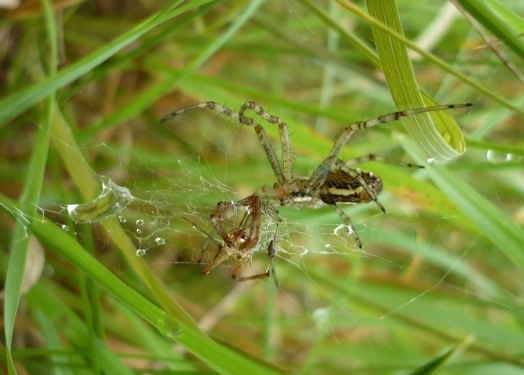
A cannibalised male Argiope bruennichi inside the female's web. Image: SM Zimmer
Love is a battlefield — and the male wasp spider (Argiope bruennichi) is one of its survivors.
Female wasp spiders usually munch on the male after they mate. Although some males survive the attack, they are faced with a conundrum: mating with the same female or looking for a new partner.
Monogynous behaviour is common among this species of orb-web spiders as it may increase the chances of fatherhood. The male wasp spider has two secondary copulatory organs known as pedipalps, which transfer sperm into the female’s reproductive organs. The pedipalps usually break inside the female, creating a plug that impedes fertilisation by a different male.
Because they only have two pedipalps, male wasp spiders can only mate twice — once if they are eaten by their first partner. Researchers at the University of Hamburg’s Zoological Institute discovered that A. bruennichi males choose their partner based on the female’s mating status, age, weight, availability of other females, and time of the day.
“Amongst spiders, regardless of age, heavier females are the most fertile. Males were more likely to mate twice with the same female if it was early in the day”¦ Males kept on searching for a second female if it was late in the day and the first female was light,” said Klass W Welke, from the University of Hamburg.
When A. bruennichi males decide to mate only once, they usually choose old female spiders. “These females are the ones which have the highest fecundity and which are most ready to lay their eggs. While these males do not have a second chance at mating their probability of reproductive success is high,” explained Welke in a press release.
Welke and his team surveyed mating decisions in a natural population over a mating season. Their results, published in the journal Frontiers in Zoology, suggest that orb-web spider males were more likely monogynous when copulating with heavy and old females.
Young females haven’t developed strong chelicerae and can’t eat their partner; but mature females, which have higher fertilisation rates and strong chelicerae, are more successful at capturing and cannibalising the males. In their paper, the authors state that any copulation longer than 10 seconds will most likely end with the death of the males.
Although monogynous male spiders have good chances of fathering healthy offspring, bigynous A. brunnechi males apparently have a more successful reproductive strategy as they mate twice before being eaten by their partner.
Source: Frontiers in Zoology






